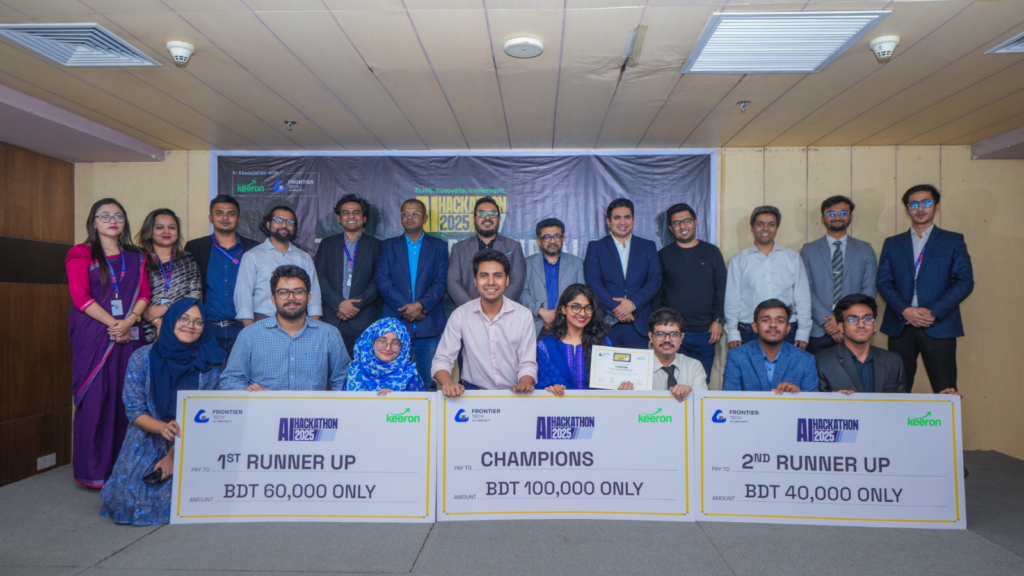The energy inside the venue was electric as AI Hackathon 2025 reached its dramatic conclusion. Designed as a globally relevant event with a strong focus on Bangladesh, the hackathon aimed to tap into the vast potential of Bangladeshi youth in artificial intelligence, fostering world-class innovation from a region poised for technological transformation. Over the past several weeks, some of the brightest young minds in AI, hailing from 28 universities, worked tirelessly to push the boundaries of AI-driven problem-solving. The event, which saw participation from 102 teams, was a vibrant showcase of creativity, technical expertise, and forward-thinking solutions that have the potential to redefine industries not just locally, but on an international scale.
From healthcare to cybersecurity, agriculture to policy-making, participants explored how artificial intelligence could be leveraged to solve real-world challenges. The hackathon was more than just a competition—it was a melting pot of ideas where students, industry experts, and AI practitioners came together to foster innovation, discuss ethical concerns, and refine AI solutions that could make a tangible impact on society.
At the heart of the event was a deep sense of purpose: AI is no longer the technology of the future; it is shaping the world today. The solutions presented throughout the hackathon demonstrated that the next generation of AI innovators in Bangladesh is ready to contribute to the global AI landscape while addressing local challenges in a meaningful way.
One of the standout projects of the event that later became the Champions was The Luminous Hypothesis – a team that pioneered an AI-powered ECG digitization system designed to enhance real-time cardiac analysis in rural healthcare settings. Their work underscored how AI can bridge the gap between medical advancements and communities that lack access to essential healthcare services. Similarly, the first runner-up Team Hobe addressed another critical healthcare issue, developing an AI-driven early detection system for diabetic retinopathy – one of the leading causes of preventable blindness. Their innovation could revolutionize screening processes and significantly reduce late-stage diagnoses. Meanwhile, the second runner-up team DU Sceptic introduced a sophisticated AI model using Optical Character Recognition (OCR) and Natural Language Processing (NLP) to improve access to medical documents in both Bangla and English, making healthcare records more accessible and efficient.
But the innovation didn’t stop there. Teams across the hackathon demonstrated how AI could revolutionize other industries. A project titled Digital Health Agent showcased AI-driven telemedicine capabilities, providing remote screenings and diagnostics to improve healthcare accessibility. Smart Farming Agent, another notable entry, integrated IoT-powered analytics into agricultural processes, optimizing irrigation, fertilization, and pest control to promote sustainable farming. Cybersecurity Agent explored cutting-edge AI-enhanced quantum encryption, reinforcing the importance of securing digital infrastructure in an increasingly connected world. Meanwhile, the Legal & Support Agent demonstrated how AI chatbots could simplify the legal landscape, helping users generate legal documents and receive instant guidance without the barriers of complexity and cost.
Throughout the hackathon, participants benefited from the insights of a panel of high-profile judges and mentors from home and abroad, whose expertise provided invaluable direction. The judging panel featured leading names in the AI and technology sectors, including Mohammad Oli Ahad, CEO of Intelligent Machines Limited; Tanvir Aumi, Principal Architect at Microsoft Office AI; Raisul Kabir, Founder & CEO of Brainstation-23; Minhajul Abedin, CTO of BRAC IT and Consultant at Prothom Alo; and Kazi Irfan Subhan, a renowned neurosurgeon at Dhaka Medical College Hospital. Their guidance emphasized not only the technical viability of the projects but also the ethical considerations and scalability of AI-powered solutions.
In addition to the competition itself, the hackathon provided a learning platform where AI thought leaders conducted focused workshops on crucial topics. Discussions ranged from AI policy and data governance to the ethical use of generative AI. Sessions on how to build AI products using no-code apps and best practices for developing AI models helped participants refine their approaches and better understand the road to real-world implementation.
The event was orchestrated by a dedicated organizing team, led by Canada-based AI Content Creation Trainer and Telfer MBA Sohan Haidear; serial entrepreneur and DU assistant professorMd Saimum Hossain, CFA; and USA-based Executive Director of the Institute of AI Impact and Governance Tasriqul Islam. Their vision and leadership, coupled with the support of esteemed partner organizations—including Keeron, Frontier Tech by Creative IT, Smartifier Training & Consultation, The Daily Star, ATL, Booked for You, GEEKY Social, SPC, Webbly Consulting Solutions, Bismo Services, SpikeStory, Excellence Bangladesh, and Movreel Studio – ensured the hackathon’s success.
With the dust settling, the question now shifts to what’s next. Several of the AI prototypes presented at the event are already being considered for further development, with some projects moving toward real-world deployment. Even ideas that didn’t make it to the final round are under evaluation for future prototyping, proving that innovation doesn’t stop at the end of a competition – it evolves and continues to shape the future.
AI Hackathon 2025 has undoubtedly left its mark. It was not just an event – it was a movement. A movement that brought together young innovators, industry leaders, and tech visionaries to build a future powered by responsible, impactful AI. As Bangladesh takes its place in the global AI landscape, the world watches the next steps of these promising projects with anticipation. One thing is clear: AI’s potential to drive positive change is just beginning to be unlocked.

